The Maldives, a small island nation located in the Indian Ocean, is known for its stunning natural beauty and unique ecosystem. With its crystal-clear waters, white sandy beaches, and abundant marine life, the Maldives is a popular destination for tourists seeking a tropical paradise.
The region boasts a warm and humid climate, with temperatures ranging from 25 to 30 degrees Celsius throughout the year. The Maldives is home to a diverse range of flora and fauna, including a variety of fish, sea turtles, and coral reefs.
The islands are also home to a number of bird species, including the Maldivian white-eye and the Maldivian paradise flycatcher. Despite its small size, the Maldives is a rich and vibrant ecosystem, offering visitors a unique glimpse into the wonders of the natural world.
.
Types Of Ants In Maldives
The Types Of Ants In Maldives are listed here: Army Ants, Trap-Jaw Ants, Funnel Ants, Carpenter And Sugar Ants, Cataulacus, Centromyrmex, Acrobat Ants, Diacamma, Dolly Ants, Harpegnathos, Crypt Ants, Shield Ants, Trailing Pharaoh And Timid Ants, Myopias, Mite-Eating Ants, Mystrium, Crazy Ants, Trap-Jaw Ants, Crazy Ants, Platythyrea, Spiny Ants, Porthole Ants, Probolomyrmex, Vampire Ants, Strongylognathus, Miniature Trap-Jaw Ants, Tapinoma.
If you’ve found some other ants in this region, contact us, and we will add them to the list!
1) Army Ants, Aenictus
Army ants are a type of ant that belong to the subfamily Dorylinae.
They are known for their aggressive behavior and their ability to form large colonies that can contain up to several million individuals.
Army ants are found in tropical and subtropical regions around the world, and they play an important role in the ecosystems where they live.
One of the most distinctive features of army ants is their nomadic lifestyle.
Unlike other ants that build permanent nests, army ants are constantly on the move, searching for food and new nesting sites.
They are also known for their impressive hunting skills.
When they come across prey, they swarm over it in large numbers, overwhelming it with their sheer numbers and powerful jaws.
Army ants are also social insects, with a complex hierarchy that determines the roles of each individual in the colony.
The queen is the largest ant in the colony and is responsible for laying eggs.
The workers are responsible for foraging, caring for the young, and defending the colony.
The soldiers are larger and have stronger jaws, which they use to protect the colony from predators.
Despite their aggressive behavior, army ants are an important part of many ecosystems.
They help to control the populations of other insects and small animals, and they provide food for larger predators such as birds and mammals.
In some cultures, army ants are even used as a source of food for humans.
Overall, army ants are fascinating creatures that have adapted to life in some of the most challenging environments on Earth.
Their nomadic lifestyle, impressive hunting skills, and complex social structure make them one of the most interesting species of ants in the world.
2) Trap-Jaw Ants, Anochetus
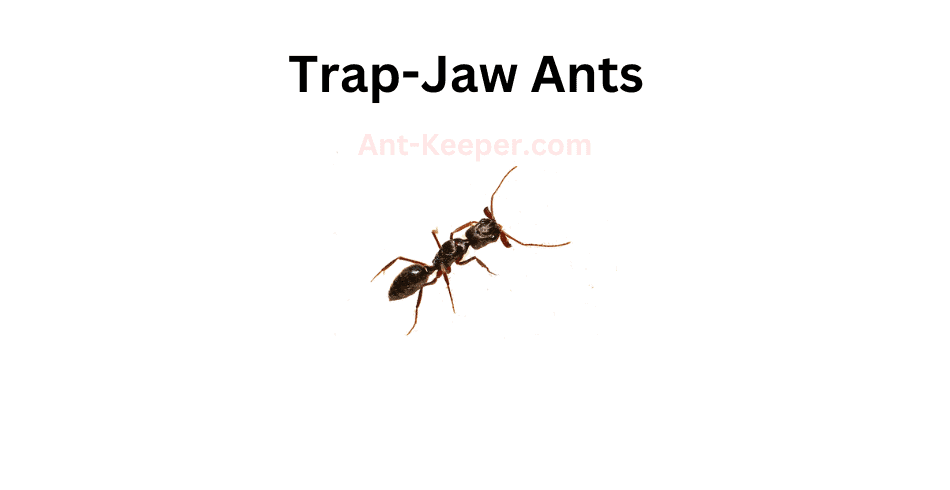
Trap-jaw ants are a species of ants that belong to the genus Odontomachus.
These ants are known for their unique and powerful mandibles, which they use to capture prey and defend their colonies.
The mandibles of trap-jaw ants are capable of closing at incredible speeds, reaching up to 140 miles per hour.
This allows them to snap their jaws shut with incredible force, which can stun or kill their prey.
Trap-jaw ants are found in a variety of habitats, including forests, grasslands, and deserts.
They are typically active during the day and are known to be highly territorial.
These ants are also known for their ability to jump, which they use to escape danger or to capture prey.
Trap-jaw ants are omnivorous, meaning that they eat both plant and animal matter.
They are known to feed on a variety of insects, including other ants, as well as nectar and other sweet substances.
These ants are also known to be scavengers, feeding on dead insects and other organic matter.
The colonies of trap-jaw ants are typically small, with only a few hundred individuals.
However, they are highly organized and have a strict social hierarchy.
The queen is the largest member of the colony and is responsible for laying eggs.
The workers, which are all female, are responsible for foraging, caring for the young, and defending the colony.
Overall, trap-jaw ants are fascinating creatures that have evolved unique adaptations to help them survive in their environments.
Their powerful mandibles and jumping abilities make them formidable predators, while their social organization allows them to work together to protect their colonies and ensure their survival.
3) Funnel Ants, Aphaenogaster
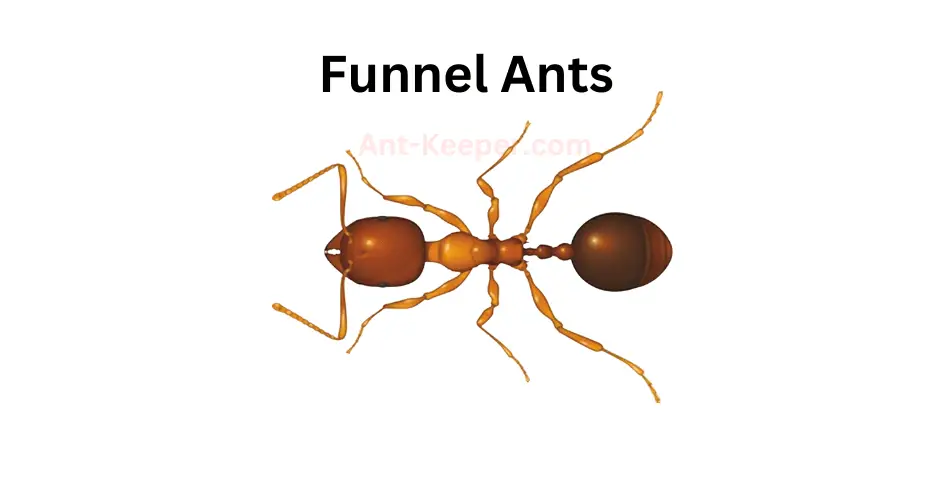
The Funnel Ants, also known as Aphaenogaster ants, are a species of ants that are commonly found in various habitats around the world.
These ants are known for their unique nesting behavior, where they construct funnel-shaped nests that are typically located in soil or leaf litter.
The Funnel Ants are relatively small in size, with workers measuring between 3-5mm in length.
They are typically reddish-brown in color and have a slender body shape.
These ants are known for their strong mandibles, which they use to collect and transport food back to their nests.
One of the most interesting aspects of the Funnel Ants is their nesting behavior.
These ants construct funnel-shaped nests that are typically located in soil or leaf litter.
The entrance to the nest is narrow and funnel-shaped, which helps to protect the colony from predators and other threats.
Inside the nest, the ants create a series of chambers and tunnels that are used for different purposes, such as storing food, caring for the brood, and housing the queen.
The Funnel Ants are omnivorous, meaning that they feed on both plant and animal matter.
They are known to collect a wide variety of food items, including seeds, insects, and other small invertebrates.
These ants are also known to tend to aphids, which they use for their honeydew secretion.
Overall, the Funnel Ants are a fascinating species of ants that are known for their unique nesting behavior and omnivorous diet.
They play an important role in their ecosystems, helping to control populations of other insects and contributing to nutrient cycling in the soil.
4) Carpenter And Sugar Ants, Camponotus

Carpenter ants and sugar ants are two common species of ants found in many regions of the world.
Carpenter ants are known for their ability to excavate wood and create nests within it.
They are typically larger in size than sugar ants and have a black or dark brown coloration.
Carpenter ants are also known for their strong mandibles, which they use to chew through wood and other materials.
Sugar ants, on the other hand, are smaller in size and have a yellow or brown coloration.
They are named for their preference for sugary foods and are often found in kitchens and other areas where food is stored.
Sugar ants are also known for their ability to form large colonies, with thousands of individual ants working together to gather food and care for their young.
Both carpenter ants and sugar ants play important roles in their ecosystems.
Carpenter ants help to break down dead wood and other plant material, which helps to recycle nutrients back into the soil.
Sugar ants help to disperse seeds and pollinate plants, which helps to maintain healthy ecosystems.
However, both species can also be pests when they invade human homes and buildings.
Carpenter ants can cause damage to wooden structures, while sugar ants can contaminate food and be a nuisance to homeowners.
It is important to take steps to prevent ant infestations and to control them if they do occur, in order to protect both human health and the health of the environment.
5) Cataulacus
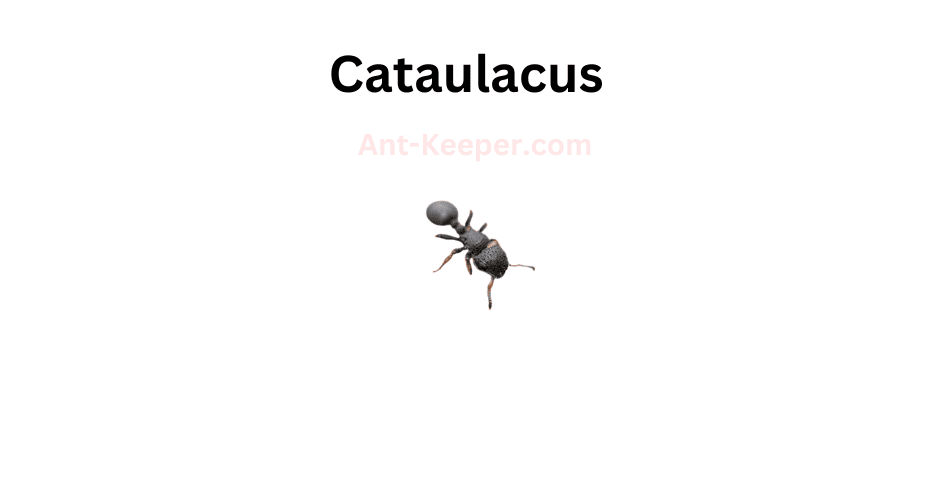
Cataulacus is a genus of ants that belongs to the family Formicidae.
These ants are known for their unique morphology and behavior.
They are small in size, measuring between 2 and 10 millimeters in length.
Cataulacus ants have a slender body with a narrow waist and long legs.
Their antennae are also long and thin, with 12 segments.
Cataulacus ants are primarily arboreal, meaning they live in trees and other vegetation.
They build their nests in hollow twigs, branches, and leaves.
These ants are also known for their ability to camouflage themselves by covering their bodies with debris and plant material.
Cataulacus ants are omnivorous, meaning they eat both plant and animal matter.
They feed on nectar, honeydew, and other sugary substances, as well as insects and other small invertebrates.
These ants are also known to tend to aphids and other insects that produce honeydew.
Cataulacus ants are social insects, living in colonies that can range in size from a few dozen to several hundred individuals.
The colony is typically led by a queen, who is responsible for laying eggs.
The workers, which are sterile females, are responsible for foraging, caring for the young, and defending the colony.
Overall, Cataulacus ants are fascinating creatures that play an important role in their ecosystem.
Their unique morphology and behavior make them a subject of interest for scientists and nature enthusiasts alike.
6) Centromyrmex
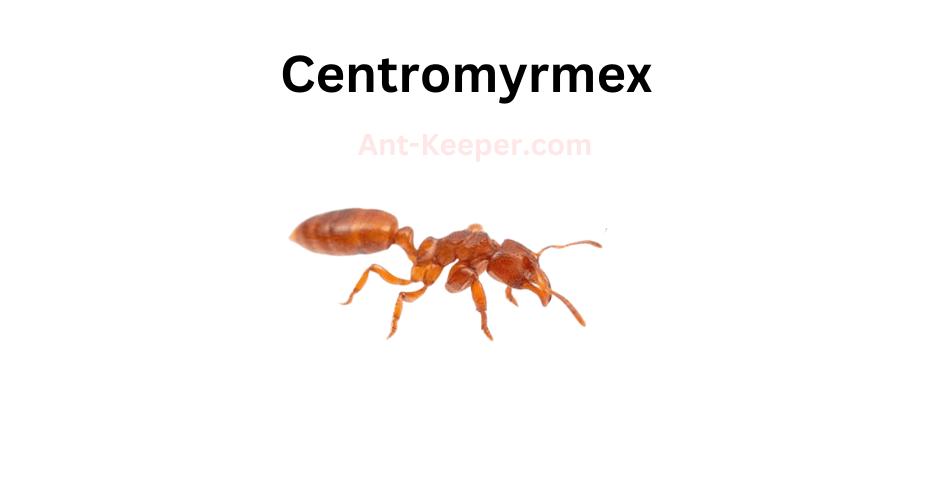
Centromyrmex is a genus of ants that belongs to the family Formicidae.
These ants are known for their unique morphology and behavior.
They are typically found in tropical regions and are known to inhabit forested areas.
Centromyrmex ants are characterized by their large size and elongated mandibles.
They are also known for their aggressive behavior and are often seen engaging in territorial disputes with other ant species.
These ants are primarily carnivorous and feed on other insects and small invertebrates.
One of the most interesting aspects of Centromyrmex ants is their reproductive behavior.
These ants are known to engage in a behavior called "pleometrosis," which involves multiple queens coexisting within a single colony.
This behavior is rare among ants and is thought to be an adaptation to the harsh conditions of their environment.
Overall, Centromyrmex ants are a fascinating and unique species that continue to intrigue scientists and researchers around the world.
Their behavior and morphology provide valuable insights into the evolution and adaptation of ants in tropical ecosystems.
7) Acrobat Ants, Crematogaster

Acrobat ants, also known as Crematogaster spp., are a genus of ants that are found in various parts of the world.
These ants are known for their unique ability to contort their bodies and move in acrobatic ways, hence their name.
Acrobat ants are relatively small, with workers measuring between 2-5mm in length.
They are typically brown or black in color, with a slender body and long legs.
These ants are known for their aggressive behavior and will readily defend their nests against intruders.
One of the most interesting features of acrobat ants is their ability to use their mandibles to grip onto surfaces and contort their bodies in unusual ways.
This allows them to move along narrow branches, twigs, and other surfaces that would be difficult for other ants to navigate.
They are also able to use this ability to escape from predators, such as birds and other insects.
Acrobat ants are omnivorous, meaning that they will eat both plant and animal matter.
They are known to feed on insects, nectar, and honeydew, as well as fruits and seeds.
These ants are also known to tend to aphids, protecting them from predators in exchange for the sweet honeydew that the aphids produce.
In terms of their social structure, acrobat ants are typically organized into colonies that are led by a queen.
The queen is responsible for laying eggs, while the workers are responsible for foraging, caring for the young, and defending the nest.
Overall, acrobat ants are fascinating creatures that have adapted unique abilities to survive in their environments.
Their acrobatic abilities and aggressive behavior make them a formidable force in the insect world.
8) Diacamma
Diacamma is a genus of ants belonging to the subfamily Ponerinae.
These ants are known for their unique behavior of forming long trails to forage for food.
They are also known for their aggressive behavior towards other ant species and their ability to defend their territory.
Diacamma ants are typically found in tropical and subtropical regions, living in forests and other wooded areas.
They are known to build their nests in soil, leaf litter, and rotting wood.
The nests are typically small and consist of a few chambers, with the queen residing in the central chamber.
These ants are relatively large, with workers measuring up to 10mm in length.
They are dark brown or black in color, with a shiny exoskeleton.
The mandibles of Diacamma ants are long and curved, allowing them to capture and subdue their prey.
Diacamma ants are omnivorous, feeding on a variety of insects, spiders, and other small invertebrates, as well as plant material.
They are also known to scavenge for food, and will often raid the nests of other ant species to steal their food.
One of the most interesting aspects of Diacamma ants is their social behavior.
They are known for their ability to form long trails to forage for food, with workers following a pheromone trail laid down by other members of the colony.
They are also known for their aggressive behavior towards other ant species, and will defend their territory fiercely.
Overall, Diacamma ants are fascinating creatures with unique behaviors and adaptations that allow them to thrive in their environments.
9) Dolly Ants, Dolichoderus

Dolly Ants, also known as Dolichoderus spp., are a species of ant that belong to the family Formicidae.
These ants are known for their distinctive elongated heads and bodies, which give them a unique appearance compared to other ant species.
Dolly Ants are typically found in forested areas, where they build their nests in soil or under rocks.
They are known to be highly social insects, living in large colonies that can contain thousands of individuals.
Within these colonies, there is a strict division of labor, with different ants taking on specific roles such as foraging, caring for the young, and defending the colony.
One interesting aspect of Dolly Ant behavior is their use of chemical communication.
These ants use pheromones to communicate with each other, leaving trails of scent that other ants can follow to locate food sources or to find their way back to the nest.
They also use pheromones to signal danger, which can trigger a coordinated response from the colony to defend against predators.
Dolly Ants are omnivorous, feeding on a variety of foods including insects, nectar, and plant sap.
They are also known to have a mutualistic relationship with certain plant species, where they protect the plants from herbivores in exchange for a source of food.
Overall, Dolly Ants are a fascinating species of ant with unique physical and behavioral characteristics.
Their social structure and use of chemical communication make them an important subject of study for researchers interested in understanding the behavior of social insects.
10) Harpegnathos
Harpegnathos is a genus of ants that belongs to the subfamily Ponerinae.
The ants in this genus are commonly known as trap-jaw ants due to their unique mandibles that can snap shut at incredible speeds, allowing them to capture prey or defend themselves from predators.
Harpegnathos ants are typically found in tropical and subtropical regions, where they live in underground nests.
These nests can be quite large, with multiple chambers and tunnels that are used for different purposes.
The ants are highly social and live in colonies that can contain thousands of individuals.
One of the most interesting aspects of Harpegnathos ants is their reproductive system.
Unlike most ant species, which have a single queen that produces all the offspring, Harpegnathos colonies can have multiple reproductive females.
These females, known as gamergates, are able to mate and lay eggs, allowing the colony to grow and expand.
Harpegnathos ants are also known for their unique behavior when it comes to foraging.
Unlike many other ant species, which send out large numbers of workers to search for food, Harpegnathos ants rely on a small group of specialized foragers.
These foragers are able to navigate complex terrain and locate food sources with incredible accuracy, allowing the colony to efficiently gather resources.
Overall, Harpegnathos ants are fascinating creatures that have evolved a number of unique adaptations to help them survive in their environments.
From their powerful mandibles to their complex social structures, these ants are a testament to the incredible diversity of life on our planet.
11) Crypt Ants, Hypoponera

Crypt ants, also known as fungus-growing ants, are a group of ants that cultivate fungi for food.
They are found in various habitats, including forests, grasslands, and deserts.
Crypt ants are known for their unique nesting behavior, as they construct underground chambers to house their fungal gardens.
These ants have a symbiotic relationship with the fungi they cultivate.
The ants provide the fungi with a suitable environment for growth, while the fungi provide the ants with a source of food.
The ants also protect their fungal gardens from other insects and parasites.
Crypt ants are social insects, living in colonies that can range from a few dozen to several thousand individuals.
The colonies are organized into castes, with the queen being the largest and most important member.
The queen is responsible for laying eggs, while the workers are responsible for tending to the fungal gardens and caring for the young.
One interesting aspect of crypt ants is their ability to create "satellite" nests.
These nests are smaller chambers located near the main nest, and they serve as storage areas for food and as a place for the queen to lay eggs.
The satellite nests are connected to the main nest by underground tunnels, allowing the ants to move between them.
Overall, crypt ants are fascinating insects that have developed a unique way of obtaining food.
Their symbiotic relationship with fungi and their complex nesting behavior make them an important species to study in the field of entomology.
12) Shield Ants, Meranoplus
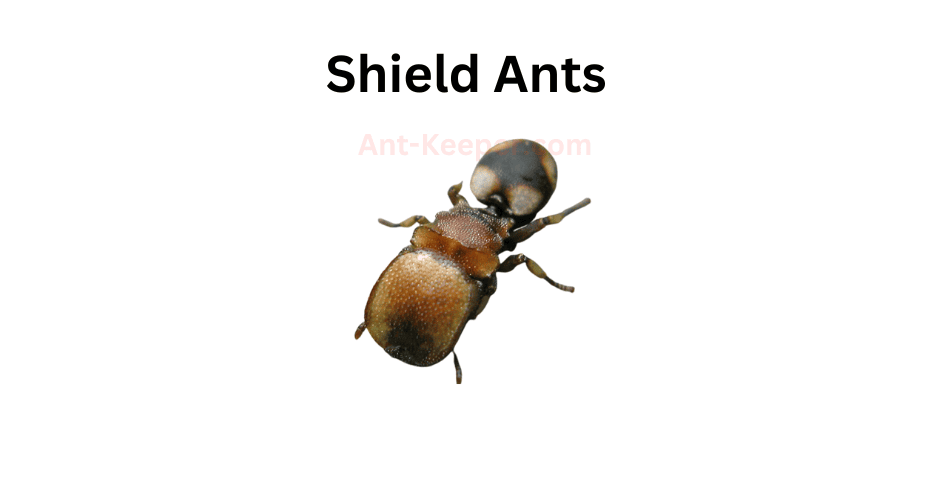
Shield ants, also known as turtle ants, are a species of ant that belong to the genus Cephalotes.
They are found in tropical regions and are known for their unique physical characteristics.
One of the most distinctive features of shield ants is their flattened, disc-shaped head.
This head shape allows them to block the entrance to their nests, protecting them from predators and other threats.
In addition, shield ants have long, spindly legs that allow them to move quickly and easily through the forest canopy.
Shield ants are social insects and live in large colonies.
They are known for their complex communication systems, which involve chemical signals and physical gestures.
They also have a division of labor within their colonies, with different ants taking on different roles such as foraging, nest building, and caring for the young.
One interesting behavior of shield ants is their use of "backpacks." Some worker ants will carry small pieces of leaves or other materials on their backs as they move through the forest.
It is believed that these backpacks may serve as camouflage or protection from predators.
Overall, shield ants are a fascinating species of ant with unique physical and behavioral adaptations that allow them to thrive in their tropical habitats.
13) Trailing Pharaoh And Timid Ants, Monomorium

The Trailing Pharaoh ant, also known as the Monomorium pharaonis, is a small, reddish-brown ant species that is commonly found in urban areas.
These ants are known for their ability to form large colonies, which can consist of thousands of individuals.
One interesting behavior of the Trailing Pharaoh ant is their tendency to trail behind other ants.
This behavior is thought to be a form of communication, as the trailing ants are able to follow the scent trail left by the leading ants.
This behavior is also used to locate food sources, as the trailing ants are able to follow the trail to the source of the food.
In contrast to the bold behavior of the Trailing Pharaoh ant, the Timid ant, also known as the Temnothorax species, is a much more cautious species.
These ants are small and brown, and are often found in wooded areas.
They are known for their timid behavior, and will often retreat into their nests when threatened.
Despite their timid nature, the Timid ant is still able to form large colonies.
They are also known for their ability to adapt to changing environments, and can be found in a variety of habitats, including forests, meadows, and even urban areas.
Overall, both the Trailing Pharaoh ant and the Timid ant are fascinating species that demonstrate unique behaviors and adaptations.
By studying these ants, scientists can gain a better understanding of the complex social behaviors and ecological roles of ants in their respective environments.
14) Myopias
Myopiasbe is a species of ant that belongs to the Formicidae family.
These ants are known for their small size, measuring only a few millimeters in length.
They have a dark brown or black coloration and a slender body shape.
Myopiasbe ants are typically found in forested areas, where they build their nests in soil or leaf litter.
These ants are known to be omnivorous, feeding on a variety of food sources including insects, nectar, and plant sap.
They are also known to be aggressive towards other ant species, often engaging in territorial disputes.
Myopiasbe ants have a unique reproductive system, with queens producing both male and female offspring.
The males are typically smaller than the females and have wings, while the females are wingless and larger in size.
These ants play an important role in their ecosystem, serving as prey for larger animals and helping to control insect populations.
They also contribute to soil health by aerating the soil and distributing nutrients.
Overall, Myopiasbe ants are a fascinating species with unique characteristics and important ecological roles.
15) Mite-Eating Ants, Myrmecina

The Mite-Eating Ant, also known as the Pheidole megacephala, is a species of ant that is commonly found in tropical and subtropical regions around the world.
These ants are known for their unique feeding habits, as they primarily feed on mites and other small arthropods.
The Mite-Eating Ant is a relatively small ant, with workers measuring between 2-3mm in length.
They have a distinctive head shape, with a large and elongated head that is almost as wide as their thorax.
Their bodies are typically a reddish-brown color, with darker legs and antennae.
These ants are highly social, living in large colonies that can contain thousands of individuals.
The colonies are typically divided into two groups: workers and reproductive individuals.
The workers are responsible for foraging for food, caring for the young, and defending the colony, while the reproductive individuals are responsible for producing offspring.
One of the most interesting aspects of the Mite-Eating Ant is their feeding habits.
These ants are specialized predators, feeding almost exclusively on mites and other small arthropods.
They use their large mandibles to capture and kill their prey, and then carry it back to the colony to be consumed.
In addition to their unique feeding habits, the Mite-Eating Ant is also known for its ability to adapt to a wide range of environments.
They are able to thrive in both natural and urban environments, and can be found in a variety of habitats, including forests, grasslands, and even in homes and buildings.
Overall, the Mite-Eating Ant is a fascinating species of ant that has adapted to a unique niche in the ecosystem.
Their specialized feeding habits and ability to thrive in a variety of environments make them an important species to study and understand.
16) Mystrium
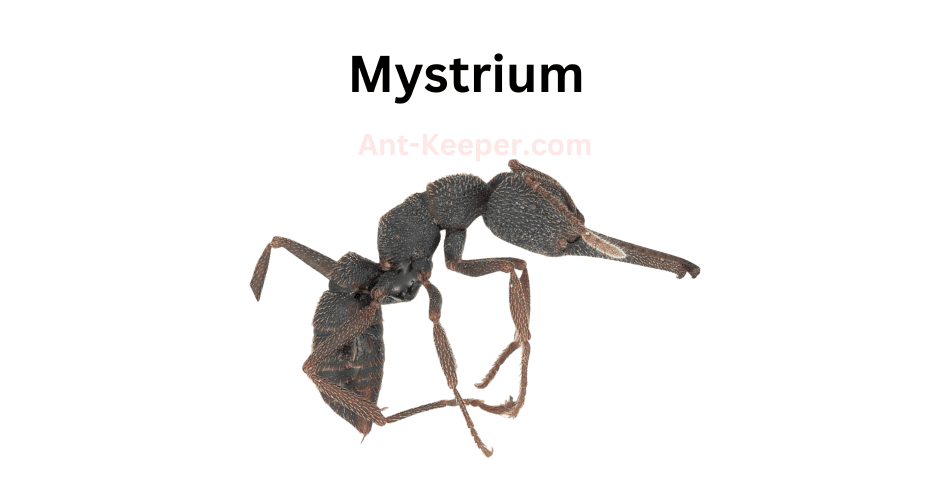
Mystrium is a genus of ants that belongs to the family Formicidae.
These ants are known for their unique morphology and behavior.
They are medium-sized ants, with workers ranging from 3 to 6 mm in length.
The head of the ant is elongated and narrow, with large mandibles that are used for hunting and defense.
The antennae are long and slender, with 12 segments.
Mystrium ants are found in a variety of habitats, including forests, grasslands, and deserts.
They are known for their aggressive behavior and are often seen attacking other ant species.
They are also known to be solitary hunters, with workers often hunting alone or in small groups.
One of the most interesting aspects of Mystrium ants is their reproductive behavior.
Unlike most ants, Mystrium ants have a unique reproductive system where the queen produces both male and female offspring.
This is known as haplodiploidy, where males are haploid and females are diploid.
The males are produced from unfertilized eggs, while the females are produced from fertilized eggs.
Mystrium ants are also known for their ability to communicate with each other through chemical signals.
They use pheromones to mark trails, identify nestmates, and signal danger.
They also use sound to communicate, with workers producing a high-pitched sound when they encounter a threat.
Overall, Mystrium ants are fascinating creatures that have unique morphology, behavior, and reproductive systems.
They play an important role in their ecosystems and are a valuable subject of study for scientists.
17) Crazy Ants, Nylanderia

Crazy ants, also known as Nylanderia fulva, are a species of ant that belong to the family Formicidae.
They are small in size, measuring only about 2.2 to 3 mm in length, and are reddish-brown in color.
These ants are known for their erratic and unpredictable behavior, hence the name "crazy ants."
Crazy ants are native to South America, but have since spread to other parts of the world, including North America, Asia, and Australia.
They are highly adaptable and can thrive in a variety of environments, including urban areas, forests, and grasslands.
One of the most notable characteristics of crazy ants is their ability to form large colonies with multiple queens.
This allows them to quickly establish themselves in new areas and outcompete other ant species.
Crazy ants are also known for their aggressive behavior towards other insects and animals, including humans.
In addition to their aggressive behavior, crazy ants are also known for their ability to cause damage to electrical equipment.
They are attracted to electrical currents and can easily short-circuit electronics, causing damage and potentially starting fires.
Despite their small size, crazy ants are a formidable species that can have a significant impact on their environment.
As they continue to spread to new areas, it is important to monitor their behavior and take steps to control their populations in order to minimize their impact on ecosystems and human infrastructure.
18) Trap-Jaw Ants, Odontomachus

Trap-jaw ants are a species of ants that belong to the genus Odontomachus.
These ants are known for their unique and powerful mandibles, which they use to capture prey and defend their colonies.
The mandibles of trap-jaw ants are capable of closing at incredible speeds, reaching up to 140 miles per hour.
This allows them to snap their jaws shut with incredible force, which can stun or kill their prey.
Trap-jaw ants are found in a variety of habitats, including forests, grasslands, and deserts.
They are typically active during the day and are known to be highly territorial.
These ants are also known for their ability to jump, which they use to escape danger or to capture prey.
Trap-jaw ants are omnivorous, meaning that they eat both plant and animal matter.
They are known to feed on a variety of insects, including other ants, as well as nectar and other sweet substances.
These ants are also known to be scavengers, feeding on dead insects and other organic matter.
The colonies of trap-jaw ants are typically small, with only a few hundred individuals.
However, they are highly organized and have a strict social hierarchy.
The queen is the largest member of the colony and is responsible for laying eggs.
The workers, which are all female, are responsible for foraging, caring for the young, and defending the colony.
Overall, trap-jaw ants are fascinating creatures that have evolved unique adaptations to help them survive in their environments.
Their powerful mandibles and jumping abilities make them formidable predators, while their social organization allows them to work together to protect their colonies and ensure their survival.
19) Crazy Ants, Paratrechina

Crazy ants, also known as Nylanderia fulva, are a species of ant that belong to the family Formicidae.
They are small in size, measuring only about 2.2 to 3 mm in length, and are reddish-brown in color.
These ants are known for their erratic and unpredictable behavior, hence the name "crazy ants."
Crazy ants are native to South America, but have since spread to other parts of the world, including North America, Asia, and Australia.
They are highly adaptable and can thrive in a variety of environments, including urban areas, forests, and grasslands.
One of the most notable characteristics of crazy ants is their ability to form large colonies with multiple queens.
This allows them to quickly establish themselves in new areas and outcompete other ant species.
Crazy ants are also known for their aggressive behavior towards other insects and animals, including humans.
In addition to their aggressive behavior, crazy ants are also known for their ability to cause damage to electrical equipment.
They are attracted to electrical currents and can easily short-circuit electronics, causing damage and potentially starting fires.
Despite their small size, crazy ants are a formidable species that can have a significant impact on their environment.
As they continue to spread to new areas, it is important to monitor their behavior and take steps to control their populations in order to minimize their impact on ecosystems and human infrastructure.
20) Platythyrea

Platythyreabe is a species of ant that belongs to the family Formicidae.
These ants are known for their unique physical characteristics, including their flattened bodies and elongated mandibles.
Platythyreabe ants are typically found in forested areas and are known to be active foragers, often hunting for small insects and other invertebrates.
One of the most interesting aspects of Platythyreabe ants is their social behavior.
These ants live in colonies that are typically composed of several hundred individuals.
Within these colonies, there is a strict hierarchy, with a single queen ant at the top.
The queen is responsible for laying eggs, while the other ants in the colony are responsible for caring for the young and maintaining the nest.
Platythyreabe ants are also known for their aggressive behavior.
When threatened, these ants will use their elongated mandibles to defend themselves and their colony.
They are also known to release a chemical signal that alerts other ants in the colony to the presence of a threat.
Despite their aggressive behavior, Platythyreabe ants play an important role in their ecosystem.
They help to control populations of small insects and other invertebrates, and they also serve as a food source for larger predators.
Overall, Platythyreabe ants are fascinating creatures that offer a unique glimpse into the complex world of social insects.
21) Spiny Ants, Polyrhachis
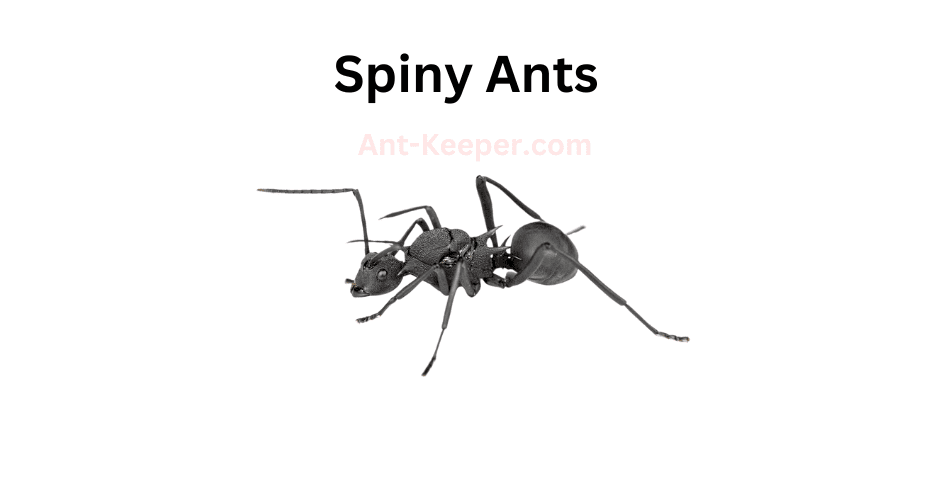
Spiny ants, also known as Polyrhachis sp., are a species of ants that belong to the family Formicidae.
These ants are known for their unique appearance, with spines covering their bodies that serve as a form of protection against predators.
Spiny ants are typically black or dark brown in color and range in size from 4 to 10 millimeters in length.
They are found in a variety of habitats, including forests, grasslands, and urban areas.
These ants are known for their aggressive behavior and will defend their nests fiercely.
Spiny ants are omnivores, feeding on a variety of food sources including insects, nectar, and honeydew.
They are also known to tend to aphids, protecting them from predators in exchange for the sweet honeydew they produce.
These ants are social insects, living in colonies that can range in size from a few dozen to several thousand individuals.
The colony is typically led by a queen ant, who is responsible for laying eggs and maintaining the colony's population.
Spiny ants play an important role in their ecosystems, serving as both predators and prey.
They help to control the populations of other insects and provide food for larger animals such as birds and reptiles.
Overall, spiny ants are a fascinating species of ants that are known for their unique appearance and aggressive behavior.
They play an important role in their ecosystems and are an important part of the natural world.
22) Porthole Ants, Ponera
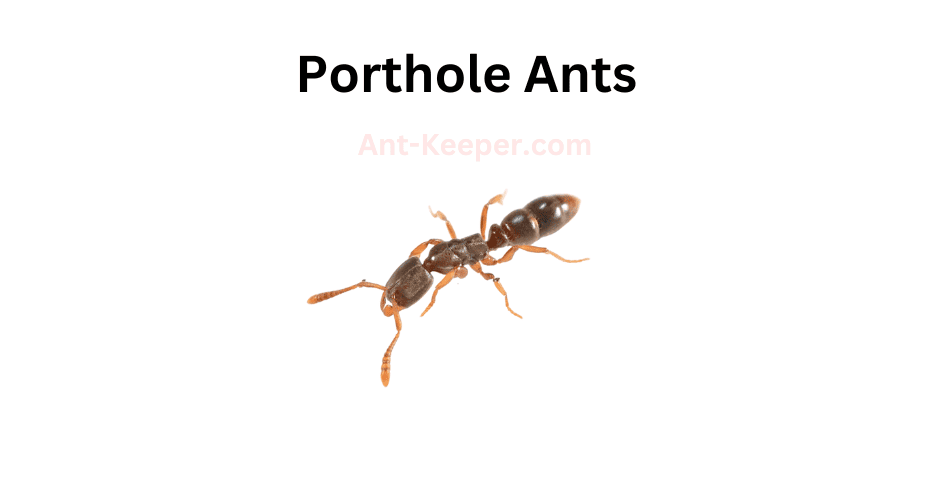
Porthole ants, also known as Temnothorax spp., are a genus of small ants that are commonly found in forested areas.
These ants are known for their unique nesting behavior, as they create their nests in small cavities or "portholes" in trees, rocks, or other natural structures.
Porthole ants are typically less than 5mm in length and have a dark brown or black coloration.
They are social insects and live in colonies that can range from a few dozen to several hundred individuals.
The colonies are typically led by a single queen, who is responsible for laying eggs and maintaining the colony's reproductive population.
One of the most interesting aspects of porthole ants is their nesting behavior.
Unlike many other ant species, porthole ants do not create large underground nests.
Instead, they seek out small cavities in natural structures and use them as their nesting sites.
These cavities can be as small as a few millimeters in diameter and are often located high up in trees or on rocky outcroppings.
Porthole ants are also known for their ability to adapt to changing environmental conditions.
They are able to quickly relocate their nests if their current nesting site becomes unsuitable due to factors such as flooding or predation.
This adaptability allows them to thrive in a variety of habitats, from temperate forests to arid deserts.
Overall, porthole ants are a fascinating and unique species of ant that have adapted to their environment in a variety of ways.
Their nesting behavior and adaptability make them an important species to study for understanding the ecology of forested areas.
23) Probolomyrmex
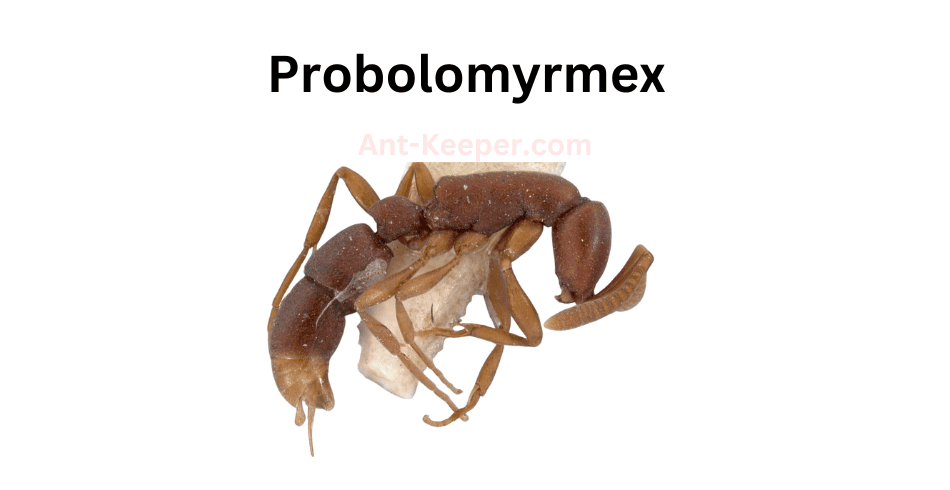
Probolomyrmex is a genus of ants that belongs to the subfamily Proceratiinae.
These ants are known for their unique morphology, which includes a long and slender body, a narrow head, and elongated mandibles.
The genus is characterized by the presence of a distinct petiole, which separates the thorax and the abdomen.
Probolomyrmex ants are typically found in tropical and subtropical regions, where they inhabit a variety of habitats, including forests, grasslands, and deserts.
They are known to be highly aggressive and territorial, often engaging in fierce battles with other ant species.
One of the most interesting aspects of Probolomyrmex ants is their social behavior.
These ants are known to be highly organized, with a well-defined caste system that includes workers, soldiers, and reproductive individuals.
The workers are responsible for foraging, nest maintenance, and caring for the young, while the soldiers defend the colony against predators and other threats.
Despite their small size, Probolomyrmex ants play an important role in their ecosystem.
They are known to be efficient predators, feeding on a variety of insects and other small invertebrates.
They also help to aerate the soil and distribute nutrients, which can have a positive impact on plant growth.
Overall, Probolomyrmex ants are a fascinating and important group of insects that are worthy of further study and conservation efforts.
24) Vampire Ants, Stigmatomma

Vampire ants, also known as blood-sucking ants, are a species of ants that feed on the blood of other insects.
These ants are known for their unique feeding behavior, which involves biting into the exoskeleton of their prey and then sucking out their blood.
Vampire ants are typically found in tropical and subtropical regions, where they live in colonies of up to several thousand individuals.
They are known for their aggressive behavior and will attack other insects, including larger prey such as grasshoppers and caterpillars.
One of the most interesting aspects of vampire ants is their ability to adapt to their environment.
In some cases, these ants have been known to feed on the blood of their own colony members when other sources of food are scarce.
Vampire ants are also known for their unique physical characteristics.
They have long, curved mandibles that are used to bite into the exoskeleton of their prey.
They also have specialized mouthparts that allow them to suck out the blood of their victims.
Despite their aggressive behavior and blood-sucking tendencies, vampire ants play an important role in their ecosystem.
They help to control the populations of other insects and contribute to the overall balance of their environment.
Overall, vampire ants are a fascinating species of ants that have adapted to their environment in unique and interesting ways.
Their behavior and physical characteristics make them a subject of interest for scientists and nature enthusiasts alike.
25) Strongylognathus

Strongylognathus is a genus of ants that belongs to the subfamily Myrmicinae.
The ants in this genus are small in size, measuring between 2 to 3 millimeters in length.
They are known for their distinctive mandibles that are long and slender, which they use to capture prey and defend their colony.
The Strongylognathus ants are typically found in forested areas, where they build their nests in soil or leaf litter.
They are known to be highly territorial and aggressive towards other ant species that invade their territory.
The ants in this genus are also known to be omnivorous, feeding on a variety of food sources including insects, nectar, and honeydew.
One of the most interesting features of the Strongylognathus ants is their ability to communicate with each other through the use of pheromones.
These chemical signals are used to mark trails, identify nestmates, and coordinate foraging activities.
The ants in this genus are also known to exhibit a high degree of social organization, with a clear division of labor among the different castes.
Overall, the Strongylognathus ants are fascinating creatures that play an important role in their ecosystem.
Their unique physical and behavioral characteristics make them a subject of interest for scientists and nature enthusiasts alike.
26) Miniature Trap-Jaw Ants, Strumigenys

The Miniature Trap-Jaw Ants, scientifically known as Odontomachus sp., are a species of ants that belong to the family Formicidae.
These ants are known for their unique and powerful mandibles, which they use to capture prey and defend their colonies.
The Miniature Trap-Jaw Ants are relatively small in size, measuring only a few millimeters in length.
They have a dark brown or black coloration and a slender body shape.
Their most distinctive feature is their mandibles, which are elongated and can snap shut with incredible force.
These mandibles are used to capture prey, crush seeds, and defend the colony against predators.
The Miniature Trap-Jaw Ants are found in a variety of habitats, including forests, grasslands, and deserts.
They are known to be active during the day and are often seen foraging for food.
These ants are omnivorous and feed on a variety of food sources, including insects, nectar, and seeds.
The Miniature Trap-Jaw Ants are social insects and live in colonies that can range in size from a few dozen to several thousand individuals.
The colony is typically led by a queen, who is responsible for laying eggs and maintaining the colony's population.
The workers are responsible for foraging, caring for the young, and defending the colony.
Overall, the Miniature Trap-Jaw Ants are fascinating insects that have evolved unique adaptations to survive in their environment.
Their powerful mandibles and social behavior make them an important part of many ecosystems.
27) Tapinoma

Tapinoma is a genus of ants that belongs to the family Formicidae.
The species Tapinoma is a small ant that measures about 2-3 mm in length.
They are commonly found in urban and suburban areas, and are known to invade homes and buildings in search of food and shelter.
Tapinoma ants are light brown in color and have a slender body with long legs.
They have a distinctively shaped head that is wider than their thorax, and they possess a pair of antennae that are bent at a right angle.
These ants are known for their ability to form large colonies, which can consist of thousands of individuals.
Tapinoma ants are omnivorous and feed on a variety of food sources, including insects, nectar, and honeydew.
They are also known to scavenge for food in garbage cans and other waste areas.
These ants are attracted to sweet and sugary substances, and will often invade kitchens and pantries in search of food.
Tapinoma ants are not known to be aggressive towards humans, but they can become a nuisance when they invade homes and buildings.
They are known to build their nests in wall voids, under floors, and in other hidden areas.
If left unchecked, these ants can cause damage to structures and can contaminate food sources.
Overall, Tapinoma ants are a common pest in many parts of the world.
While they are not harmful to humans, they can be a nuisance when they invade homes and buildings.
Proper pest control measures can help to prevent infestations and keep these ants at bay.
Check Out Some Of Our Other Ants By Location Posts
| Types Of Ants In Puerto Rico | Puerto Rico, a Caribbean island located in the northeastern Caribbean Sea, is a region known for its diverse and unique environment. The island’s tropical climate, ... |
| Types Of Ants In Zacatecas, Mexico | Zacatecas, a region located in north-central Mexico, is a land of diverse landscapes and unique wildlife. The region is characterized by its arid climate, with ... |
| Types Of Ants In Piaui, Brazil | Piauí, a state located in northeastern Brazil, is a region known for its unique environment and diverse wildlife. The state is characterized by its hot ... |
| Types Of Ants In Nauru | Nauru, a small island nation located in the Pacific Ocean, is a unique and fascinating place. Despite its small size, Nauru boasts a diverse range ... |
| Types Of Ants In Saint Martin (French Part) | Saint Martin, located in the northeastern Caribbean Sea, is a small island divided between two nations: the French and the Dutch. The French part of ... |
